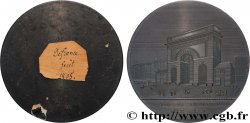E-auction 397-310538 - fme_457646 - NAPOLEON'S EMPIRE Médaille, Bataille de Wagram - épreuve uniface du revers
Чтобы принять участие в торгах, вы должны войти в систему и стать подтвержденным участником аукциона. Войдите, чтобы сделать ставку. Ваш аккаунт будет подтвержден в течение 48 часов. Не ждите до закрытия торгов, чтобы зарегистрироваться.Сделав ставку на данный товар, вы вступаете в юридическое соглашение на покупку выбранного товара и нажатием кнопки «Сделать ставку» подтверждаете принятие вами условий интернет-аукционов cgb.fr.
Ставка может бить сделана только в полном эквиваленте евро. Торги закроются согласно времени, указанному в описании товара, все ставки, сделанные после закрытия торгов, учитываться не будут. Не следует откладывать предложение вашей ставки до последнего момента, так как система может не успеть обработать вашу заявку, и ваша ставка не будет принята. Более детальную информацию вы найдёте здесь: FAQ по интернет-аукционам.
БЕСПЛАТНО.
БЕСПЛАТНО.
| Оценить : | 75 € |
| Цена : | 37 € |
| Максимальная предлагаемая цена : | 43 € |
| Конец торгов : | 23 November 2020 18:26:00 |
| Участников : | 4 Участников |
Тип Médaille, Bataille de Wagram - épreuve uniface du revers
Дата: 1809
Монетный двор / Город: France
Металл: lead
Диаметр: 40 mm
Ориентация осей монеты: 12 h.
Гравер GALLE André (1761-1844)
Вес: 16,25 g.
Век: Lisse
Пуансон: sans poinçon
Комментарии о состоянии
Superbe revers avec de très beaux reliefs. Fine patine grise avec du brillant de frappe mais présentant néanmoins des traces de manipulation
Происхождение:
Cet exemplaire provient de la descendance directe du graveur Auguste-François Michaut (1786-1879)
Лицевая сторона
Аверс: легенда: LISSE.
Обратная сторона
Реверс: легенда: BATAILLE DE WAGRAM. / VI JUILLET M D CCCIX..
Реверс: Описание: Hercule levant sa massue au-dessus d’un géant à terre et retenant une victoire, avec sa palme et sa couronne, de la main gauche. Signé : DENON D. GALLE F..
Комментарий
Médaille signée au revers DENON D. GALLE F.
La bataille de Wagram (5-6 juillet 1809) a été décisive pour l'issue de la guerre de la Cinquième Coalition. Elle a eu lieu dans les plaines Marchfeld (de), sur la rive nord du Danube, la principale zone de combats se localisant aux environs du village de Deutsch-Wagram, à 10 km au nord-est de Vienne. Les deux jours de lutte ont vu s'imposer l'armée impériale française, sous le commandement de Napoléon Ier face à l'armée impériale autrichienne commandée par l'archiduc Charles d'Autriche-Teschen. La bataille de Wagram fut la plus meurtrière des batailles qui avaient eu lieu jusqu'alors, et ne sera égalée ou dépassée que par les batailles de la Moskova et Leipzig. Après le combat, épuisées et ayant subi de très lourdes pertes, les forces françaises ne peuvent poursuivre leur ennemi. Néanmoins, la situation des Autrichiens, déjà très difficile avant le combat, devient alors désespérée après la défaite.
.
Medal signed on the reverse DENON D. GALLE F. The Battle of Wagram (5-6 July 1809) was decisive for the outcome of the War of the Fifth Coalition. It took place in the Marchfeld plains (de), on the north bank of the Danube, the main fighting zone being located around the village of Deutsch-Wagram, 10 km northeast of Vienna. The two days of fighting saw the French Imperial Army, under the command of Napoleon I, prevail against the Austrian Imperial Army commanded by Archduke Charles of Austria-Teschen. The Battle of Wagram was the bloodiest battle that had taken place up to that point, and would only be equaled or surpassed by the Battles of Borodino and Leipzig. After the battle, exhausted and having suffered very heavy losses, the French forces were unable to pursue their enemy. However, the situation of the Austrians, already very difficult before the battle, became desperate after the defeat.
La bataille de Wagram (5-6 juillet 1809) a été décisive pour l'issue de la guerre de la Cinquième Coalition. Elle a eu lieu dans les plaines Marchfeld (de), sur la rive nord du Danube, la principale zone de combats se localisant aux environs du village de Deutsch-Wagram, à 10 km au nord-est de Vienne. Les deux jours de lutte ont vu s'imposer l'armée impériale française, sous le commandement de Napoléon Ier face à l'armée impériale autrichienne commandée par l'archiduc Charles d'Autriche-Teschen. La bataille de Wagram fut la plus meurtrière des batailles qui avaient eu lieu jusqu'alors, et ne sera égalée ou dépassée que par les batailles de la Moskova et Leipzig. Après le combat, épuisées et ayant subi de très lourdes pertes, les forces françaises ne peuvent poursuivre leur ennemi. Néanmoins, la situation des Autrichiens, déjà très difficile avant le combat, devient alors désespérée après la défaite.
.
Medal signed on the reverse DENON D. GALLE F. The Battle of Wagram (5-6 July 1809) was decisive for the outcome of the War of the Fifth Coalition. It took place in the Marchfeld plains (de), on the north bank of the Danube, the main fighting zone being located around the village of Deutsch-Wagram, 10 km northeast of Vienna. The two days of fighting saw the French Imperial Army, under the command of Napoleon I, prevail against the Austrian Imperial Army commanded by Archduke Charles of Austria-Teschen. The Battle of Wagram was the bloodiest battle that had taken place up to that point, and would only be equaled or surpassed by the Battles of Borodino and Leipzig. After the battle, exhausted and having suffered very heavy losses, the French forces were unable to pursue their enemy. However, the situation of the Austrians, already very difficult before the battle, became desperate after the defeat.








 Cообщить об ошибке
Cообщить об ошибке Распечатать страницу
Распечатать страницу Отправить мой выбор
Отправить мой выбор Задать вопрос
Задать вопрос Consign / sell
Consign / sell
 Информация
Информация










